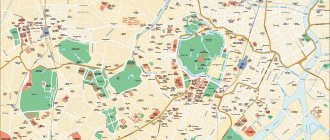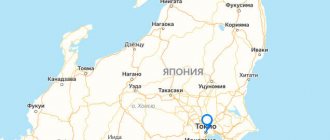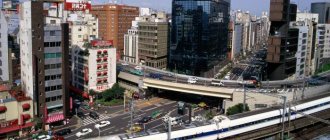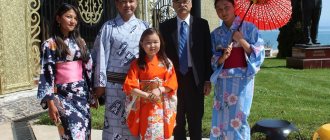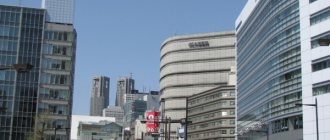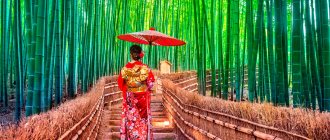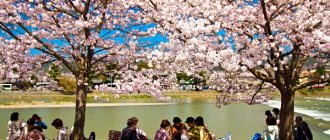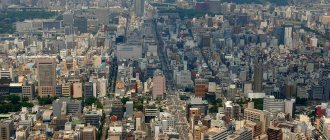The official name of the eastern country consists of two hieroglyphs, which in Russian transcription read as “Nihon”, which means “the place where the Sun rises”. The first European ships landed on the shores of this amazing and mysterious country only in 1543, and the process of “discovering Japan” began. Let us discover this country for ourselves and visit the largest cities in Japan, both in terms of population and area.
14 largest Japanese cities by population:
14
Nagano
Population ≈ 378 thousand
In the very center of the Japanese island of Honshu lies the beautiful city of Nagano, whose history dates back to April 1, 1897.
A relatively small city with a population of 378 thousand inhabitants. Among the attractions, a large Buddhist center stands out, and around the city there are picturesque mountain landscapes and a beautiful river valley.
There is also a unique park of Jigokudani monkeys, who live near thermal springs. Like Sapporo, Nagano was lucky enough to host the 1998 Winter Olympics.
13
What is rural Japan?
Each person defines the concept of “rural” in his own way. In Russia, it is more often associated with a hopeless wilderness or a small village with one store and the absence of any entertainment. But in Japan, the countryside is much better developed. This word often means any settlements located outside the metropolis. Roughly speaking, a small town can also be rural. Large metropolitan areas usually include Tokyo, Osaka, Kyoto and Sapporo. The remaining settlements are considered provincial.
Russian business will soon receive a global digital platform
Yandex will buy a popular online clothing store
The most insightful: 4 zodiac signs that even a fraudster cannot deceive
Small villages adjacent to megacities are called suburbs by the Japanese. Life there is not so fast and exhausting. Foreigners mistakenly believe that they cannot get along with provincial Japanese. And in vain. More often than not, they are even friendlier than city residents.
Nagasaki
Population ≈ 513 thousand
Another city in Japan that was subjected to atomic bombing by the United States in August 1945. But hardworking residents rebuilt their city, and today it is one of the most beautiful in the country.
Today, a little more than 513 thousand people live in Nagasaki, and in the area where the epicenter of the explosion was, there is now a calm, peaceful suburb of one-story Japan.
“Long Cape,” as the name of the city is translated from Japanese, was founded in 1579. It is noteworthy that this eastern city has the largest number of Christians.
Living in the suburbs can help you improve your spoken Japanese
Yes, Tokyo and Kyoto have a much higher concentration of foreigners and tourists. In the centers of metropolitan areas, all restaurants and shops have English-speaking employees. It's the same in large companies. Sometimes it happens that foreigners do not feel the need to speak Japanese at all. Therefore, their knowledge of the language does not improve in any way, although they have lived in the country for years.
Get the facts ready: How to ask for a raise during a pandemic
“Another performance”: Morgenstern called the court decision “excellent PR”
In Russia they want to introduce paternal capital for many children in addition to maternal capital
Outside the megacities, the situation changes dramatically. In the suburbs, you won't find English-speaking staff or translated signs. To navigate the space, you will have to speak and read Japanese. It will be difficult to get the hang of at first, but it will be worth it. This is good practice for those who do not yet know the language well. In the suburbs, all your neighbors will be Japanese, so you will also improve your conversational Japanese skills. This will help you negotiate better at work.
Sendai
Population ≈ 1.03 million
The city traces its history back to 1600. It was founded by the samurai, the largest Japanese feudal lord Date Masamune. First, an impenetrable castle was built, around which a settlement grew.
The historical part of the city was badly damaged as a result of American bombing in July 1945, more than 11 thousand houses were destroyed, but the Japanese quickly restored everything after the end of the war.
With its streets, Sendai faces the Pacific coast, and is protected from strong winds by the Ou Mountains. The city is located in one of the most picturesque places in Japan. Tourists come here to enjoy the natural beauty and get acquainted with traditional Japanese culture.
11
Hiroshima
Population ≈ 1.199 million
The settlement of the territories of modern Hiroshima began approximately 300 years before the beginning of our era, and in 1589, by order of Terumoto, a beautiful castle was built here.
A settlement arose near the castle, which was named Hiroshima, which means “Wide Island”. Off the coast of the city, right in the water, there is a unique landmark of the Shinto religion - the Torii of Itsukushima Shrine.
The city had to endure a terrible tragedy when the Americans dropped a nuclear bomb on it.
10
Saitama
Population ≈ 1.19 million
The city, part of the greater Tokyo metropolitan area, is one of the youngest. The founding date is considered to be May 1, 2001. The government, in the course of improving the administrative division, united three cities under one name.
The city received new railway lines as Japan prepared to host the World Cup. Residents love football, because Saitama has two football teams, and the stadiums are always full of fans.
In addition to football, there are many figure skating fans here. To host international competitions in this beautiful sport, the Saitama Super Arena multifunctional stadium was specially built.
9
Kawasaki
Population ≈ 1.37 million
To the southwest of the Japanese capital lie the multi-storey neighborhoods and traditional houses of the city of Kawasaki. The settlement is known all over the world by the name of the corporation of the same name, which produces excellent motor vehicles.
Kawasaki plays an important role in the transport system of Japan, so a deep-water port was built here. The city itself is divided into seven districts, and the historical part is full of attractions of a secular and religious nature.
It is noteworthy that the city with a large number of residents does not have a metro system. And the reason is that Kawasaki is located on the ocean, and therefore groundwater simply does not allow the creation of deep stations.
8
Japanese in the suburbs are better at making contact with foreigners
Foreigners are afraid to come to the suburbs because of the stereotype that the Japanese are closed and unfriendly. In megacities, visitors can communicate with each other without contacting locals. But in rural areas there are practically no foreigners. Therefore, many of them are afraid that they will be left alone without friends and acquaintances.
Igor Ledogorov and other celebrities whose birthday falls on May 9
Buy in bulk, get cashback: convenient ways to save if you live alone
Long training, income: traumatologist in Russia - pros and cons of the profession
In fact, this stereotype is wrong. The smaller the city in Japan, the easier it will be for you to meet and make friends with the locals. Russians are also called gloomy, but we always accept foreigners with friendliness. So it is in Japan. Local residents show great interest in all visitors, especially if you are the only foreigner in the village. The Japanese will treat you with all their hospitality and you will easily make friends.
Fukuoka
Population ≈ 1.43 million
The history of the modern city began with the small port of Na. The port directly accessed the Sea of Japan, and therefore became an important center of trade with Korea and China. The territories developed and the city increased significantly in size. In addition to the Japanese, Chinese and Korean traders lived here. But after the severance of relations with the mainland, the city lost its former significance. In 1972, Fukuoka became a city divided into districts.
The city has several symbols, including the sea gull, since the neighborhoods directly face the sea coast. Here, one of the tallest coastal Japanese skyscrapers, Fukuoka Tower, soars into the sky.
7
It's sometimes easier to find a job in the suburbs
Most often, foreigners come to Japan as English teachers. If you are working in Tokyo or another metropolis, the requirements for your experience and knowledge will be incredibly high. The candidate must be ideal, which is why many foreigners are eliminated at the stage of submitting their resume. At this point they give up trying to move to Japan, but in vain.
Rural prefectures also need more teachers. At the same time, the requirements for them are not as high as in the capital. And schools in remote areas are sometimes willing to accept candidates without experience. Yes, the salary will not be too high, but you will definitely get a visa. After all, working in the provinces is a great way to improve your skills and get a job in the capital.
Found a violation? Report content
Kyoto
Population ≈ 1.465 million
For a long period of its history, Kyoto was the capital of the state and the location of the residence of the emperors. But then it was called Heian.
In and around the city of Kyoto there are about 1,600 Buddhist temples and more than 400 Shinto kumri.
Today, the center of the Kansai region is the country's largest industrial and financial center with a population of 1 million 465 thousand inhabitants. The oldest capital of Japan is very popular among tourists all over the world. But domestic tourism has not bypassed the beautiful city. Middle and high school students come here on their graduation trips. The editors of TheBiggest really dream of visiting this large Japanese city.
6
The cost of living in the suburbs and rural areas is much lower
As in Russia, the cost of living in megacities is significantly higher. Tokyo, Osaka and Kyoto are the most expensive cities in Japan. Prices for food and clothing are significantly higher here. Restaurants and cafes are also more expensive, especially in the center. The demand for real estate is huge, so even renting a small room will cost a fortune.
Things are much better in the provinces. Prices here are much lower. According to a report from the Bureau of Statistics of Japan, the most expensive prefectures are:
- Tokyo;
- Kyoto;
- Osaka;
- Kanagawa;
- Hyogo.
The list was completed by the five cheapest prefectures:
- Ehime;
- Kumamoto;
- Miyazaki;
- Gunma;
- Okinawa.
These are all provincial areas, local Japanese call them “rural”. The only exception is Okinawa. This prefecture is located on a separate island, which the Japanese consider a resort.
Far fewer people live in rural prefectures. The cost of living in them is lower, but one nuance must be taken into account: the salaries of foreigners cannot be called high either. If you work in the suburbs, don't expect a huge salary. As a rule, foreigners come here to teach Japanese children and teenagers English. These are vacancies with average wages. But in Tokyo and Kyoto, this salary would not even be enough for you to rent a house. And in the suburbs you can not only rent an apartment, but also lead a relatively comfortable life, even saving your finances.
The best option: settle in a suburb near the metropolis. Yes, you will have to spend more time traveling to your workplace, but your salary will be higher and rent will be cheaper.
Kobe
Population ≈ 1.53 million
For the first time, a settlement in the historical province of Inzumi was mentioned in an ancient treatise of 201. In the Middle Ages and Modern times, it was the largest port through which goods passed to Kyoto.
Today the port is also of great importance in the economic life of Japan. Even the emblem of the city is two crossed fans, meaning two large ports. The headquarters of the largest Japanese companies are located here, and the most beautiful attraction is the Akashi-Kaikyo Bridge, built over the waters of Akashi Bay.
At one time, the Ikuta sanctuary was created here, and the name of the city comes from the name of the ministers who perform rituals in the sacred place.
5
Time to travel.
The ideal time to visit Osaka is spring, when the cherry blossoms begin to bloom, and autumn, when the leaves fall golden. You can admire cherry blossoms in every park in the city, but Nagai Park . Here, not only locals, but also tourists walk along the paths laid between the trees. You can watch the autumn leaf fall in Osaka Castle Park or Hoshida Park .
You can visit Osaka at any time of the year. In each season, the city will allow tourists to see its beauty.
Sapporo
Population ≈ 1.97 million
The most important industrial, cultural and educational center of Japan, the city of Sapporo spreads its straight streets and neighborhoods among the most beautiful mountain peaks.
Every year, 2 million tourists come to the city with a population of 1 million 970 thousand residents for the Snow Festival. There are many resorts around the residential area where you can ski and get healthy in hot springs.
In addition, there are many attractions within the city limits, and Sapporo itself is known to the world as the city where the 1972 Winter Olympics took place.
4
Niigata is the central city of the prefecture of the same name.
Niigata is a large metropolis with an area of 726 square meters. km. It is located on the coast of the Sea of Japan, which allows it to develop rapidly. In addition to work, the Japanese flock here to receive a prestigious education. Several universities, including the International University of Japan, enroll thousands of students. Niigata is known to tourists as the city of festivals. Niigata is considered one of the main business centers of Japan, and it is an extremely beautiful city.
One of the best activities for travelers is a trip along the Agano River on a large boat with all the amenities. Shibata Castle is luxurious and majestic. This is the most striking example of Japanese architecture from the feudal times of the 17th century. The building remains the only castle preserved on the territory of the prefecture. That is why it has national significance for Japanese culture. A notable place is the sake production plant, where you can learn all the details of making the famous Japanese drink. Families should visit the city's aquarium, while nature lovers will love the Sasagawa coastline. According to the Japanese themselves, the most interesting is the steam locomotive, which is still in operation. This spectacle looks especially beautiful during the cherry blossoms growing along the railway.
Nagoya
Population ≈ 2.28 million
Archaeological research has confirmed that sites on the site of the modern city appeared during the Upper Paleolithic. Already in the 1st millennium it was a densely populated area of the Japanese islands.
The symbol of the city is interesting. This is the hieroglyph for "8" that is enclosed in a circle. Symbolism in infinity. The number eight is a symbol of infinity throughout the world, as well as a circle that has no beginning or end. This symbolizes the endless development of the Japanese city.
For more than half a century, Nagoya has firmly ranked fourth in terms of population among the largest cities in the Land of the Rising Sun.
3
Osaka
Population ≈ 2.67 million
In the southern part of the island of Honshu, on the beautiful shore of Osaka Bay, lies the city of the same name. In 596-654 the town was the capital and the imperial palace was located here.
During the Middle Ages, the port city was an important trading center through which goods were distributed to all the islands and regions of Asia. In 1956, Osaka became a city and the center of a prefecture by a separate decree.
There are many attractions within the neighborhoods, including the famous Buddhist temples of Isshin-ji and the oldest Shitenno-ji temple. The population fluctuated in the 20th century due to frequent earthquakes, but now it is the third largest city in terms of the number of inhabitants.
2
List of cities in Japan
| # | Name, city | Population, people |
| 1 | Tokyo | 8 967 741 |
| 2 | Yokohama | 3 681 315 |
| 3 | Osaka | 2 668 200 |
| 4 | Nagoya | 2 259 780 |
| 5 | Sapporo | 1 896 223 |
| 6 | Kobe | 1 538 924 |
| 7 | Kyoto | 1 463 482 |
| 8 | Fukuoka | 1 461 686 |
| 9 | Kawasaki | 1 420 393 |
| 10 | Saitama | 1 220 754 |
| 11 | Hiroshima | 1 181 141 |
| 12 | Sendai | 1 060 356 |
| 13 | Kitakyushu | 981 162 |
| 14 | Chiba | 960 649 |
| 15 | Sakai | 839 021 |
| 16 | Niigata | 811 894 |
| 17 | Shizuoka | 715 904 |
| 18 | Sagamihara | 714 193 |
| 19 | Okayama | 705 446 |
| 20 | Kumamoto | 670 442 |
| 21 | Kagoshima | 605 267 |
| 22 | Funabashi | 586 782 |
| 23 | Hachioji | 567 450 |
| 24 | Kawaguchi | 552 921 |
| 25 | Himeji | 536 195 |
| 26 | Matsuyama | 515 140 |
| 27 | Higashiosaka | 509 212 |
| 28 | Utsunomiya | 507 887 |
| 29 | Matsudo | 477 661 |
| 30 | Nishinomiya | 477 082 |
| 31 | Kurashiki | 472 490 |
| 32 | Ichikawa | 470 243 |
| 33 | Oita | 467 316 |
| 34 | Fukuyama | 461 451 |
| 35 | Amagasaki | 461 238 |
| 36 | Kanazawa | 455 687 |
| 37 | Nagasaki | 448 875 |
| 38 | Yokosuka | 421 447 |
| 39 | Toyama | 421 130 |
| 40 | Toyota | 420 362 |
| 41 | Takamatsu | 419 486 |
| 42 | Machida | 413 874 |
| 43 | Gifu | 412 842 |
| 44 | Hirakata | 406 266 |
| 45 | Fujisawa | 402 699 |
| 46 | Kashiwa | 389 120 |
| 47 | Toyonaka | 387 309 |
| 48 | Nagano | 378 256 |
| 49 | Toyohashi | 377 079 |
| 50 | Ichinomiya | 375 951 |
| 51 | Wakayama | 372 230 |
| 52 | Okazaki | 371 429 |
| 53 | Miyazaki | 369 484 |
| 54 | Nara | 367 438 |
| 55 | Suita | 354 677 |
| 56 | Takatsuki | 354 303 |
| 57 | Asahikawa | 350 592 |
| 58 | Iwaki | 350 026 |
| 59 | Kochi | 342 993 |
| 60 | Takasaki | 341 906 |
| 61 | Koriyama | 339 445 |
| 62 | Tokorozawa | 338 637 |
| 63 | Kawagoe | 335 763 |
| 64 | Akita | 329 307 |
| 65 | Otsu | 329 086 |
| 66 | Koshigaya | 318 645 |
| 67 | Maebashi | 318 127 |
| 68 | Naha | 314 190 |
| 69 | Yokkaichi | 306 669 |
| 70 | Aomori | 305 967 |
| 71 | Kurume | 305 242 |
| 72 | Kasugai | 300 811 |
| 73 | Morioka | 299 802 |
| 74 | Akashi | 292 227 |
| 75 | Fukushima | 289 400 |
| 76 | 289 262 | |
| 77 | Shimonoseki | 286 122 |
| 78 | Nagaoka | 281 321 |
| 79 | Ichihara | 279 688 |
| 80 | Hakodate | 277 089 |
| 81 | 273 319 | |
| 82 | Ibaraki | 272 317 |
| 83 | Fukui | 268 647 |
| 84 | Kakogawa | 267 651 |
| 85 | Tokushima | 266 381 |
| 86 | Mito | 264 104 |
| 87 | Hiratsuka | 260 475 |
| 88 | Yamagata | 255 411 |
| 89 | Sasebo | 254 664 |
| 90 | Futu | 248 527 |
| 91 | Kure | 246 196 |
| 92 | Hachinohe | 241 700 |
| 93 | Saga | 239 991 |
| 94 | Neyagawa | 239 114 |
| 95 | Juice | 237 983 |
| 96 | Fuji | 237 295 |
| 97 | Kasukabe | 236 935 |
| 98 | Chigasaki | 231 045 |
| 99 | Matsumoto | 227 424 |
| 100 | Atsugi | 225 252 |
| 101 | Yamato | 223 177 |
| 102 | Ageo | 222 555 |
| 103 | Takarazuka | 222 154 |
| 104 | Chofu | 219 068 |
| 105 | Ota | 214 116 |
| 106 | Tsukuba | 207 366 |
| 107 | Numazu | 206 835 |
| 108 | Joetsu | 206 247 |
| 109 | Kumagaya | 204 896 |
| 110 | Isesaki | 204 266 |
| 111 | Kishiwada | 200 606 |
| 112 | Tottori | 200 348 |
| 113 | coffee | 199 404 |
| 114 | Odawara | 198 938 |
| 115 | Suzuka | 197 507 |
| 116 | Matsue | 195 954 |
| 117 | Hitachi | 195 861 |
| 118 | Itami | 194 513 |
| 119 | Nishitokyo | 193 364 |
| 120 | Yamaguchi | 192 037 |
| 121 | Uji | 191 370 |
| 122 | Higashihiroshima | 187 771 |
| 123 | Hirosaki | 185 897 |
| 124 | Kodaira | 185 880 |
| 125 | Yachiyo | 184 744 |
| 126 | Kushiro | 182 303 |
| 127 | Mitaka | 180 821 |
| 128 | Hino | 179 535 |
| 129 | Izumi | 179 450 |
| 130 | Takaoka | 179 015 |
| 131 | Ube | 176 406 |
| 132 | Anjo | 176 069 |
| 133 | Tachikawa | 175 698 |
| 134 | Tomakomai | 173 832 |
| 135 | Kamakura | 173 665 |
| 136 | Iwata | 172 609 |
| 137 | Sakura | 171 567 |
| 138 | Imabari | 171 057 |
| 139 | Matsusaka | 169 654 |
| 140 | Miyakonojo | 169 441 |
| 141 | Hadano | 169 299 |
| 142 | Obihiro | 168 273 |
| 143 | Ishinomaki | 163 851 |
| 144 | Ogaki | 163 126 |
| 145 | Oyama | 162 344 |
| 146 | Ueda | 161 962 |
| 147 | Toyokawa | 161 609 |
| 148 | Narasino | 159 776 |
| 149 | Urayasu | 159 391 |
| 150 | Ashikaga | 157 855 |
| 151 | Kawanishi | 157 549 |
| 152 | Nagareyama | 156 718 |
| 153 | Sayama | 156 698 |
| 154 | Niiza | 155 974 |
| 155 | Hitachinaka | 155 358 |
| 156 | But yes | 153 483 |
| 157 | Xionang | 150 347 |
| 158 | Tama | 149 482 |
| 159 | Yonago | 149 150 |
| 160 | Komaki | 149 122 |
| 161 | Iruma | 148 271 |
| 162 | Onomichi | 148 136 |
| 163 | Iwakuni | 146 915 |
| 164 | Higashimurayama | 146 663 |
| 165 | Moriguchi | 146 324 |
| 166 | Fukaya | 146 203 |
| 167 | Izumo | 146 140 |
| 168 | Kakamigahara | 145 143 |
| 169 | Kariya | 145 163 |
| 170 | Koga | 144 445 |
| 171 | Tsuchiura | 144 070 |
| 172 | Isahaya | 142 728 |
| 173 | Ome | 141 767 |
| 174 | Kuwana | 140 830 |
| 175 | Tsuruoka | 140 147 |
| 176 | Musashino | 138 602 |
| 177 | Inazawa | 137 536 |
| 178 | Osaka | 137 258 |
| 179 | Yatsushiro | 134 564 |
| 180 | Ise | 133 640 |
| 181 | Abiko | 133 576 |
| 182 | Nobeoka | 132 495 |
| 183 | Seto | 132 335 |
| 184 | Iizuka | 132 271 |
| 185 | Otaru | 130 336 |
| 186 | Kadoma | 130 051 |
| 187 | Fujieda | 129 734 |
| 188 | Aizuwakamatsu | 129 437 |
| 189 | Karatsu | 129 237 |
| 190 | Misato | 129 001 |
| 191 | Okinawa | 128 444 |
| 192 | Osyu | 128 337 |
| 193 | Minoo | 127 800 |
| 194 | Kirishima | 127 763 |
| 195 | Dzama | 127 614 |
| 196 | Omuta | 127 506 |
| 197 | Beppu | 127 402 |
| 198 | Asaka | 126 989 |
| 199 | Ebina | 126 061 |
| 200 | Daito | 125 898 |
The website chislennost.com uses information from official sources and is updated every month. Some data may vary due to the lack of the latest census.
Yokohama
Population ≈ 3.732 million
The largest port city, located on the western Pacific coast of the island of Honshu, has just over 3.732 million inhabitants.
The city began its history with the unification of two villages, and this happened in 1858, and a year later the port opened its berths for foreign ships. It was in Yokohama that diplomatic missions and consulates of foreign states, including the Russian Empire, were located.
There is a lot to see and do in the city. First of all, this is a huge city dolphinarium and a historical museum with exhibitions of unique artifacts.
1
Life in the suburbs is more relaxed
Japan's megacities are truly crowded with people. If you take the metro during rush hour, you will see huge crowds of locals. They do not fit at stations and do not fit into carriages. Therefore, subway employees have to push people, literally pushing them onto trains, to close their doors. If you decide to drive to work, be prepared to get stuck in traffic for an hour or more. The rhythm of megacities is often called crazy. People everywhere are constantly in a hurry and late for something. They simply do not have time not only for conversations, but also for banal politeness.
A hairdryer and peanut butter will help: 6 ways to remove a label without a trace
Russia will ensure collective immunity in offices and enterprises
Cryptocurrency tax law may be adopted this fall
In the suburbs the pace of life is much slower. There are no traffic jams or crushes here, so no one is rushing to work in the morning. Local residents often get around in their cars, bicycles, and even on foot. And rural roads are in no way inferior to city ones. Yes, there are fewer luxury boutiques and fine dining restaurants. But instead of them you will find small shops and cozy cafes. Rural areas are much quieter and the air here is much cleaner.
If you need to travel to a metropolis, on average you can get there in just a couple of hours.
Tokyo
Population ≈ 13.929 million
Eastern Capital, as the name of this largest city in Japan is translated from Japanese. Until 1868, it was called Edo, after the castle that was the seat of the Tokugawa shogunate.
After World War II, as a result of the so-called “Japanese economic miracle,” Tokyo became the largest financial capital in the world, with a highly developed infrastructure.
The population of the Japanese capital is 13.929 million people, but millions of tourists visit the city every year. Let us note that experts and journalists unanimously agree that this is the safest city in the world.
